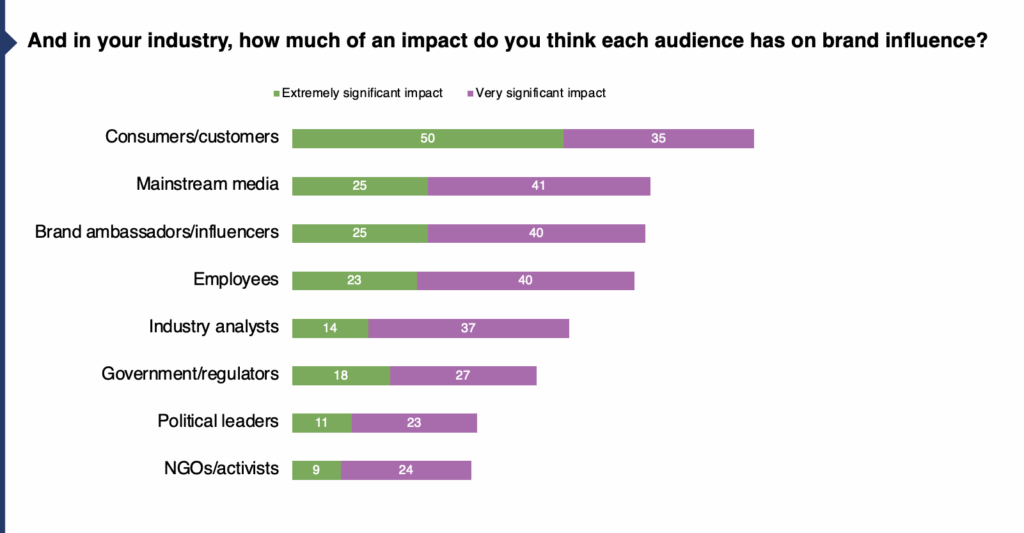What Today’s Brands Must Do to Stay Credible and Connected
Brand strategy is undergoing a transformation. Influence, once treated as a byproduct of visibility, has become the metric that defines long-term relevance.
The shift is being driven by rising expectations and a growing demand for authenticity.
Today’s customers expect brands to be good corporate citizens, treat employees well, and communicate their values clearly. As a result, brand influence is no longer a communications function alone.
It now reflects the entire organization’s behavior, from leadership decisions to employee advocacy.
These sentiments rose to the top in a recent global research conducted by agencies of the Public Relations Global Network (PRGN), which partnered with Researchscape to survey more than 500 marketing, communications, and business leaders worldwide. While the study confirmed the growing importance of brand influence, which was cited as “extremely” or “very” important by 89% of respondents, it also revealed some gaps. With nearly half of respondents reporting that their current approach to building brand influence needs to be improved, the tension between aspiration and execution is real.
What the Most Influential Brands Do Differently
The brands most admired for their influence (such as Apple, Coca-Cola, and Nike) were recognized for clarity, consistency, and the ability to inspire trust across audiences. They show up with purpose across platforms. They create experiences that reflect what they stand for. And they ensure that internal culture matches external positioning.
When asked which factors most strongly influence brand perception, survey respondents highlighted five characteristics: reputation and trust (both cited by 94% of leaders), followed by relevance to consumers (87%), authenticity (84%), and emotional connection (77%).
Employees Play an Often-Unrecognized Role in Shaping Brand Perception
One of the most underleveraged drivers of brand influence is the employee voice. Not the scripted kind in a corporate video, but the organic, unscripted kind that shows up in LinkedIn posts, onboarding feedback, and hallway conversations.
When employees are aligned with the brand’s purpose and feel invested in its trajectory, their influence becomes an extension of the brand’s. When they are not, the disconnect shows. That’s why internal engagement has become non-negotiable.
 The research reinforces this point: 63% of respondents cited employee trust as a major factor influencing brand credibility. That is a wake-up call for organizations that still treat internal engagement as an HR issue rather than a brand driver.
The research reinforces this point: 63% of respondents cited employee trust as a major factor influencing brand credibility. That is a wake-up call for organizations that still treat internal engagement as an HR issue rather than a brand driver.
Reputation Takes Time, But It Pays Dividends
Influence isn’t won with a single campaign. It’s built through behavior. And while that’s a slower path, it’s also more resilient. In times of disruption, brands that have invested in credibility and consistency fare better. They’re more likely to be forgiven when they stumble and more likely to be followed when they lead.
Too often, brands emphasize driving sales at the expense of reputation.
When brands focus solely on conversion, they risk missing the deeper opportunity to build influence, create long-term value, and foster resilience across cycles.
The research suggests that leaders increasingly recognize this, as brand equity and customer loyalty are gaining traction as key influence metrics.
For companies without built-in name recognition, third-party validation is especially important. Editorial visibility, thought leadership, and credible partnerships may not always produce immediate clicks, but they build the kind of trust and alignment that compound over time. Notably, the study found that earned media is still viewed as one of the most effective tools for building influence, especially for brands that cannot rely on legacy reputation.
Measurement Needs to Catch Up
Influence is shaping where brands invest and how they grow, but many teams still measure success with outdated tools. Clicks and reach have their place, but they cannot tell you whether people believe you, trust you, or want to associate with your brand.
The PRGN study found that while customer loyalty and brand equity are on the rise as influence metrics – selected as priority metrics by 42% and 19% of respondents, respectively – many organizations still default to surface-level performance data. That disconnect is holding brands back from tracking what actually matters.
The takeaway?
If you are only tracking performance, you’re missing perception. And perception is where influence begins.
A New Playbook for Influence
This isn’t just a trend. It’s a reset. Influence has become a core strategic driver that touches brand, culture, leadership, and experience. The brands that win are the ones that recognize that influence cannot be bought. It must be built, and rebuilt, every day.
In a world that is moving faster and expecting more, brands that lead with credibility, consistency, and conviction will set the pace.
Explore the full PRGN study for more insights on how global brands are earning influence today.
[prgn_pdf_download pdf_link=”https://prgn.cullencommunications.ie/wp-content/uploads/2025/04/PRGN-Influence-Insights-global-presentation_Apr.29.2025.pdf” title=”PRGN Influence Insights Survey” description=”Find detailed results of PRGN’s Influence Insights global survey by downloading our presentation” button=”Download Now”]
And listen to the PRGN Presents podcast episode with Bill Southard and Natalie Ghidotti, who dive into the data, especially with regards to The Americas region: